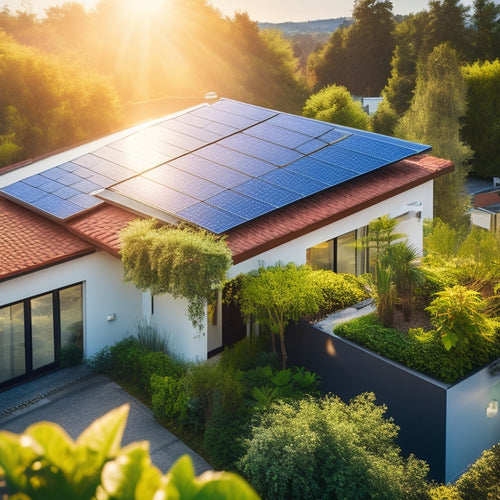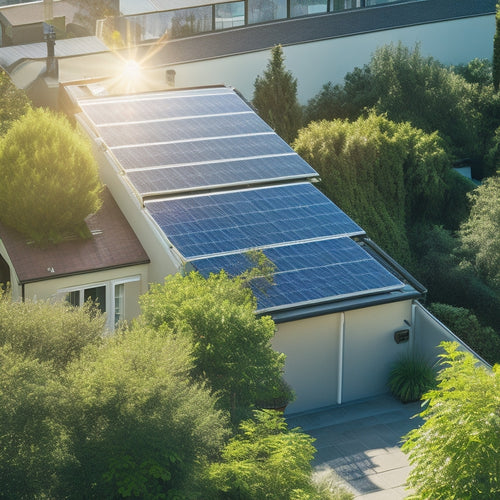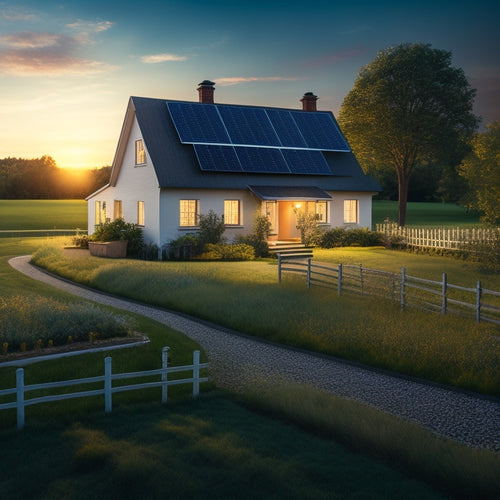
Solar Panel Array Images for Educational Purposes
Share
You're seeking high-quality solar panel array images for educational purposes, and understanding the complexities of these systems is essential for ideal energy output and efficiency. Diagrams illustrate vital components, like inverters and connections, and help identify energy loss areas. You'll learn about various types of solar arrays, including ground-mounted and roof-top installations, each with their own set of considerations. Residential, commercial, and solar farm installations have unique benefits, such as reduced energy costs, increased property value, and environmental impact. As you examine these systems, you'll uncover more about the components, installation processes, and innovations driving the solar industry forward.
Key Takeaways
- Solar panel array images aid in understanding system components, energy flow, and potential energy loss areas for optimal energy output and system efficiency.
- Diagrams help identify essential components, such as solar panels, inverters, and connections, for quick problem identification and maintenance.
- Images of different solar array types, like ground-mounted and roof-top installations, facilitate comparison and selection for specific use cases.
- Visual representations of residential and commercial solar panel systems illustrate the installation process, highlighting critical factors like roof suitability and energy needs assessment.
- Images of solar panel systems can demonstrate energy efficiency benefits, such as reduced energy costs and increased property value, for educational purposes.
Solar Panel Diagrams Explained
When designing a solar panel array, understanding solar panel diagrams is vital to guarantee ideal energy output and system efficiency. You'll want to make certain that your solar panel diagram accurately represents the electrical connections and physical layout of your system.
A well-designed diagram will help you identify potential issues and optimize solar panel efficiency. In your diagram, you'll typically see a series of symbols and notations that represent different components, such as solar panels, inverters, and mounting hardware.
These symbols will indicate the direction of energy flow, electrical connections, and other important system details. By studying your solar panel diagram, you'll be able to identify areas where energy losses may occur, allowing you to take corrective action to maximize your system's performance.
Regularly reviewing your solar panel diagram is also vital for solar panel maintenance. By checking your diagram, you can quickly identify potential problems, such as faulty connections or malfunctioning components, and schedule repairs to minimize downtime and energy losses.
Different Types of Solar Arrays
You'll encounter two primary categories of solar arrays: ground-mounted systems and roof-top installations.
Ground-mounted systems are designed to optimize energy production by adjusting the angle and orientation of the panels, while roof-top installations offer a more compact, space-saving solution.
Each type has its unique benefits and challenges, which you'll need to evaluate when selecting a solar array configuration that suits your specific needs.
Ground-Mounted Systems Design
Across various terrains, ground-mounted systems have become a popular choice for utilizing solar energy, particularly in areas with abundant open space.
When designing a ground-mounted system, you'll need to take into account site selection, guaranteeing the area receives ideal sunlight. Conduct a shading analysis to identify potential obstructions and enhance array orientation.
Soil stability is essential, as it affects the system's structural integrity and weather resilience. Environmental impact and regulatory compliance must also be assessed to confirm your system meets local standards.
Maintenance practices, including performance monitoring and inverter selection, are significant for ideal energy production. You'll need to balance installation costs with system scalability and energy storage requirements.
Aesthetic considerations, such as the system's visual appeal, may also influence your design decisions.
Roof-Top Installation Options
Designing a roof-top installation requires careful evaluation of the various solar array options available.
You'll need to weigh factors like installation aesthetics, energy output, and rooftop regulations to determine the best fit for your project.
One popular option is the traditional rack-mounted system, which involves attaching solar panels to a racking system secured to your roof.
This configuration provides flexibility regarding panel angle and direction, allowing you to optimize energy production.
However, it may compromise your roof's appearance and potentially void its warranty.
An alternative is the integrated solar roof, where solar panels replace traditional roofing materials.
This option streamlines the installation process and enhances installation aesthetics, but it can be more expensive and may not be suitable for all roof types.
You'll also need to assess building-integrated photovoltaics (BIPV), which involve integrating solar panels into the building envelope.
BIPV systems can provide additional structural benefits, but they often require more complex installation and may have higher upfront costs.
Residential Solar Panel Systems
When you install a residential solar panel system, you'll need to understand the system installation process, which involves evaluating your energy needs, selecting the right equipment, and configuring the array to optimize energy production.
By doing so, you'll be able to reap the energy efficiency benefits, such as reducing your reliance on the grid and lowering your electricity bills.
As you investigate residential solar panel systems, you'll uncover how these benefits can translate to significant cost savings over time.
System Installation Process
Typically, the system installation process for residential solar panel systems begins with a thorough assessment of your roof's structural integrity and solar exposure. This is vital to guarantee your roof can support the weight of the solar panels and that they'll receive ideal sunlight.
Your installation team will evaluate your roof's age, condition, and design to identify potential installation challenges. They'll also analyze your local building codes and regulations to assure compliance.
Once your roof is deemed suitable, the installation team will prepare the site by clearing the area and covering your vegetation and landscaping. They'll then install the mounting system, which secures the solar panels to your roof.
The solar panels are then carefully placed on the mounting system, and the electrical connections are made. Finally, the system is tested and inspected to verify it's functioning properly.
To maximize energy production, it's important to follow maintenance tips, such as cleaning your solar panels regularly and monitoring your system's performance. By doing so, you'll be able to enjoy the full benefits of your residential solar panel system.
Energy Efficiency Benefits
By investing in a residential solar panel system, you'll access a multitude of energy efficiency benefits that can greatly reduce your reliance on the grid and lower your energy bills.
With solar panels, you'll generate clean energy on-site, reducing your consumption from the grid and decreasing your energy costs.
Here are some key benefits you can expect:
-
Reduced Energy Costs: By generating your own energy, you'll lower your reliance on the grid and reduce your energy bills.
-
Increased Property Value: Installing a residential solar panel system can increase your property value, making it more attractive to potential buyers.
-
Solar Incentives: You may be eligible for solar incentives, such as tax credits or rebates, which can help offset the initial cost of installation.
- Environmental Impact: By switching to clean, renewable energy, you'll reduce your carbon footprint and contribute to a more sustainable future.
Commercial Solar Panel Installations
Across rooftops and parking garages, commercial solar panel installations are altering the urban environment, utilizing the power of the sun to fuel businesses and industries. As you consider investing in a commercial solar panel installation, you'll want to investigate the various options available to you.
| Commercial Solar Option | Description |
|---|---|
| Commercial Leasing | Lease solar panels from a provider, reducing upfront costs |
| Solar Financing | Secure loans or financing options specifically designed for solar installations |
| Tax Incentives | Take advantage of federal and state tax credits for solar investments |
When it comes to installation, you'll want to ascertain that your provider meets industry standards, such as those set by the International Electrotechnical Commission (IEC). Regular maintenance practices, like panel cleaning and performance monitoring, will also help optimize energy production. Additionally, consider partnering with utility companies to investigate energy storage options and take advantage of renewable energy policies. By understanding these key aspects, you'll be well on your way to utilizing the power of solar energy for your business.
Solar Farm Aerial Views
From above, solar farms present a striking visual vista, with rows upon rows of photovoltaic panels stretching towards the horizon. Their uniform arrangement is a demonstration of the precision engineering that underlies these renewable energy installations.
As you gaze upon these aerial views, you begin to appreciate the sheer scale and complexity of these operations.
-
Carbon footprint reduction: Witness the tangible impact of solar farms on the environment, as they generate clean energy and reduce our reliance on fossil fuels.
-
Energy independence: Marvel at the ability of solar farms to power entire communities, freeing them from the grip of traditional energy providers.
-
Economic growth: See the economic benefits of solar farms, as they create jobs, stimulate local economies, and attract investment.
- Innovation hub: Recognize the role of solar farms as testbeds for state-of-the-art solar technology advancements, driving the industry forward and pushing the boundaries of what's possible.
As you take in these breathtaking views, you're reminded of the numerous solar farm benefits and the rapid progress being made in solar technology advancements.
Solar Panel Efficiency Comparison
You're likely interested in understanding how different solar panels stack up regarding energy conversion rates.
To make informed comparisons, you'll want to examine panel performance metrics, such as efficiency ratings, capacity factors, and power output per unit area.
Energy Conversion Rates
As solar panels continue to emerge as a viable alternative energy source, understanding their energy conversion rates becomes increasingly essential. You need to know how efficiently they convert sunlight into usable electricity to make informed decisions about your energy investments.
The energy conversion rate, also known as solar panel efficiency, affects various aspects of your solar panel system. It influences your energy storage needs, solar incentives, and panel maintenance requirements. A higher conversion rate means a reduced environmental impact, lower installation costs, and faster grid integration.
Furthermore, it benefits from technological advancements, reducing performance degradation over time.
Here are 4 key implications of energy conversion rates:
-
Higher efficiency, lower costs: More efficient panels require less space to generate the same amount of power, reducing installation costs.
-
Increased energy independence: With higher conversion rates, you can store more energy and rely less on the grid.
-
Enhanced environmental benefits: More efficient panels lead to a greater reduction in greenhouse gas emissions.
- Stronger market trends: Advancements in energy conversion rates drive growth in the solar industry, influencing solar policy and market trends.
Panel Performance Metrics
When evaluating solar panels, understanding panel performance metrics is vital to making informed decisions. You need to know how efficiently they convert sunlight into electricity, their expected lifespan, and potential environmental impact.
Efficiency optimization is significant, as it directly affects energy yield. Look for panels with high energy conversion rates and minimal panel degradation over time.
Performance analysis is important to assess a panel's effectiveness. You should consider factors like system monitoring, maintenance practices, and installation challenges that may affect its operation.
Technology advancements have improved panel efficiency, but it's vital to weigh these benefits against cost effectiveness.
Environmental impact is another key consideration. Opt for panels with a lower carbon footprint and recyclable materials.
Grid-Tied Solar Panel Systems
Grid-tied solar panel systems, the most common type of solar panel system, account for nearly 90% of all solar installations worldwide.
As someone interested in utilizing the power of solar energy, you're likely drawn to this type of system because of its efficiency and cost-effectiveness.
Grid-tied systems allow you to generate your own electricity and export any excess to the grid, offsetting your energy consumption and reducing your utility bills.
You'll also benefit from solar incentives, such as net metering, which enables you to sell excess energy back to the grid and receive credits.
This setup also contributes to grid stability, as it helps balance the electrical grid during peak demand periods.
Here are four key benefits of grid-tied solar panel systems:
- Maximize your energy savings: By generating your own electricity, you can considerably reduce your energy bills.
- Increase your property value: Installing a grid-tied system can enhance your property's value and appeal.
- Enhance grid stability: By feeding excess energy back into the grid, you're helping to stabilize the electrical grid.
- Take advantage of incentives: You'll be eligible for solar incentives, such as tax credits and rebates, that can offset the cost of your system.
Off-Grid Solar Panel Configurations
Your remote location or desire for energy independence has led you to contemplate off-grid solar panel configurations, which allow you to generate and store your own electricity without connecting to the grid.
Off-grid systems require solar storage, typically in the form of deep-cycle batteries, to provide power when the sun isn't shining. Battery integration is vital to guarantee a seamless shift between solar power and stored energy.
With off-grid configurations, you'll achieve true energy independence, free from reliance on the grid. However, this comes with added responsibilities, such as regular maintenance practices to guarantee system performance and longevity.
System scalability is also important, as your energy needs may change over time. Hybrid systems, which combine solar with other power sources like wind or diesel generators, can provide additional reliability.
Inverter technology plays a significant role in converting DC power to AC, while load management systems optimize energy distribution.
When considering off-grid solar, be prepared for higher installation costs, but also expect long-term savings and real-time performance monitoring to guarantee your system operates at peak efficiency.
Solar Panel Mounting Options
You've carefully considered your off-grid solar panel configuration and are now ready to decide on the ideal solar panel mounting options for your system. The right mounting solution guarantees your solar panels operate at peak efficiency while withstanding environmental stressors.
When selecting a mounting option, consider the following essential factors:
-
Structural integrity: Verify the mounting hardware can support the weight of your solar panels and withstand weather conditions.
-
Shading analysis: Identify potential shading sources and adjust your mounting orientation to maximize energy production.
-
Site assessment: Evaluate your roof materials and adjust your installation techniques accordingly.
- Weather considerations: Choose adjustable mounts or solar trackers that can adapt to changing weather patterns, guaranteeing peak energy generation.
Innovative Solar Panel Designs
Turning to the aesthetic and functional aspects of solar panels, inventive designs have emerged to enhance their appeal and performance. You'll notice that these advancements prioritize solar aesthetics, ensuring that your solar panel array not only generates power but also complements its surroundings. One significant trend is the incorporation of sustainable materials, reducing the environmental footprint of solar energy production.
| Innovative Design Feature | Description |
|---|---|
| Bifacial Solar Panels | Capture light from both the front and back sides, increasing energy output by up to 25% |
| Solar Skins | Thin, flexible panels that can be integrated into building facades, enhancing urban solar adoption |
| Frameless Solar Panels | Sleek, edge-to-edge designs that improve durability and reduce material waste |
These state-of-the-art designs cater to your desire for efficient, eco-friendly power generation. By embracing inventive solar panel designs, you can reveal the full potential of your solar array while minimizing its environmental impact.
Frequently Asked Questions
Can I Use Solar Panels to Charge My Electric Vehicle?
You can utilize solar energy benefits to charge your electric vehicle, but consider charging efficiency: a 5-10 kW solar array can fully charge your car in 4-8 hours, depending on your vehicle's capacity and the array's power output.
How Do I Clean Solar Panels Without Damaging Them?
As you gaze up at your solar panel array, imagine dust and debris obstructing the path to maximum energy harvesting. To avoid this, you'll want to employ gentle yet effective cleaning techniques for solar panel maintenance, using soft brushes, deionized water, and a touch of soap to keep them sparkling and efficient.
Are Solar Panels Recyclable at the End of Their Life?
You'll be relieved to know that, at the end of their 25-30 year lifespan, solar panels can be recycled, and you'll play a key role in this process, ensuring precious materials like silicon, aluminum, and glass are reclaimed through efficient recycling processes.
Can I Install Solar Panels on a Metal Roof?
You can install solar panels on a metal roof, but you'll need to evaluate the metal roof benefits, such as durability and reflectivity, alongside installation considerations, like ensuring a secure attachment and waterproofing, to maximize energy output.
Do Solar Panels Work During a Power Outage?
When the grid goes dark, you're stuck in the dark ages, but with solar panels, you're not entirely powerless. You can opt for off-grid systems, pairing solar panels with a solar battery, ensuring you stay lit during outages, like a guiding light in the dark.
Conclusion
As you've examined the various solar panel array images, you've likely noticed the vast range of designs and configurations. But did you know that research suggests that optimizing solar panel angles can increase energy output by up to 45%? This concept, known as "bifacial gain," is revolutionizing the industry. By understanding the complexities of solar panel arrays, we can access even greater potential for renewable energy and pave the way for a sustainable future.
Related Posts
-

Solar Power Systems for Cost-Effective Sustainability
Investing in solar power systems is a smart move for cost-effective sustainability. You can save about $1,500 annuall...
-

How Solar Panels Reduce Electricity Bills
Solar panels can drastically cut your electricity bills by utilizing sunlight to generate your own energy. This decre...
-

Cost-Effective Solar Solutions for Rural Homes
Cost-effective solar solutions can alter your rural home by enhancing energy independence and slashing utility bills....


